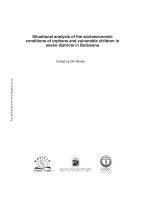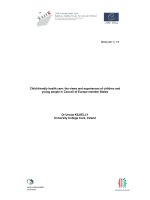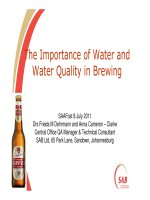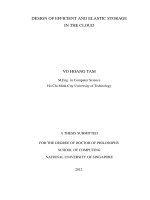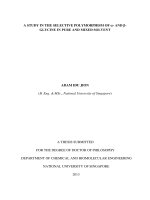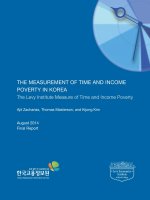Evaluate the inhibitory ability of fungicides and biocontrol agents against Pyricularia oryzae and Helminthosporium oryzae in vitro
Bạn đang xem bản rút gọn của tài liệu. Xem và tải ngay bản đầy đủ của tài liệu tại đây (273.38 KB, 7 trang )
Int.J.Curr.Microbiol.App.Sci (2020) 9(8): 3569-3575
International Journal of Current Microbiology and Applied Sciences
ISSN: 2319-7706 Volume 9 Number 8 (2020)
Journal homepage:
Original Research Article
/>
Evaluate the Inhibitory Ability of Fungicides and Biocontrol Agents against
Pyricularia oryzae and Helminthosporium oryzae in vitro
Gaurav Kumar Yadav1, Ramesh Singh Yadav1*, Gopal Singh1, Kamal Khilari1,
Prashant Mishra1 and Hem Singh2
1
Department of Plant Pathology, 2Department of Entomology, Sardar Vallabhbhai Patel
University of Agriculture & Technology, Meerut-250110, (U.P.) India
*Corresponding author
ABSTRACT
Keywords
Fungicides,
Concentration,
Bio-agents,
Basmati, Inhibition
Article Info
Accepted:
26 July 2020
Available Online:
10 August 2020
The study was carried out to evaluate the efficacy of fungicides and bio-agents against the
blast and brown spot disease in basmati rice under in vitro condition. All three fungicides
(Tricyclazole75% WP, Propiconazole 25% EC and hexaconazole 5% EC) were found
quite effective against the blast and brown spot disease of basmati rice. These fungicides
were tested at three different concentrations i.e. 25 ppm, 50 ppm and 100 ppm. The bioagents (Trichoderma harzianum and Pseudomonas fluorescence) were less effective as
compared to fungicides. Among the evaluated fungicides propiconazole shows maximum
mycelium inhibition percent of P. oryzae both 25ppm and 50ppm concentration level that
was 64.44% and 76.30% while at 100ppm concentration tricyclazole (87.41%) shows
maximum inhibition percent. Hexaconazole was most superior and shows maximum
mycelial growth inhibition of H. oryzae at all above three concentration of fungicide.
Among the eco-friendly treatment P. fluorocens expressed better bio-agent against P.
oryzae and H. oryzae as compared to T. harzianum.
Introduction
Rice (Oryza sativa L.) is the grain with
second highest worldwide production after
maize (Boumas, 1985). It belongs to the
family Graminae. Rice is the predominant
dietary energy source for 17 countries in Asia
and the Pacific, 9 countries in North and
South America and 8 countries in Africa. Rice
is providing 20% of the world dietary energy
supply, while wheat supplies 19% and maize
5%. It is the staple food in developing
countries. Rice is a high energy or high
calorie food. In India, area under cultivation
of non-Basmati rice is 431.94 lakh hectare
with total output of 110.15 million tones with
an average productivity of 2550 kg/ha
(Department of Agriculture and cooperation,
Govt. of India, 2018).
Basmati rice holds a place of pride for India
due to its aroma and cooking quality. This
rice with extra-long, soft textured grain is
being cultivated since time immemorial in the
foot hills of Himalayas. India is the major
producer and suppliers of basmati rice to the
3569
Int.J.Curr.Microbiol.App.Sci (2020) 9(8): 3569-3575
world consumers. The Basmati rice area
across major Indian states (Jammu &
Kashmir,
Himachal
Pradesh,
Punjab,
Haryana, Delhi, Uttrakhand and Western
Uttar Pradesh) is 1515.00 thousand ha with
Production of 5027.00 thousand tones. The
area and production of Basmati rice in
Western Uttar Pradesh is 251.00 thousand ha
and 730.00 thousand tones (APEDA, 2018)
respectively. Basmati rice is known to be
attacked by many pests and diseases which
cause huge losses annually worldwide.
Among fungal diseases of rice, rice blast
(Pyricularia oryzae) and brown spot
(Helminthosporium oryzae) is of significant
economic importance. Outbreaks of rice blast
and brown spot diseases are a serious and
recurrent problem in all rice growing regions
of the world. It is estimated that each year
enough of rice is destroyed by rice blast alone
to feed 60 million people (Zeigler et al.,
1994). Brown spot disease causes severe yield
loss in 1942 in West Bengal popularly known
as Bengal famine and yield loss reaches up to
90% in certain areas (Sarkar et al., 2014).
Currently these diseases are being managed
by application of chemical fungicides such as
tricyclozole, propiconazole, hexaconazole,
carbendazim, mancozeb, etc. and many
workers have reported these chemicals are
effective against rice blast (Hegde, 2015).
Some workers were worked on the evaluation
of organic or botanical product for
management of rice blast and brown spot
diseases. Management through fungicides is
one of the most widely used management
methods, but they are costly and at the same
time the chemical have an adverse impact on
environment. However, current research
indicates another potential option for plant
disease management through the use of
biocontrol agents (Nirmalkar et al., 2017).
The objectives of the study were to develop a
cost effective protection measures for
management of rice diseases for sustainable
yield.
Materials and Methods
Experiment was conducted to evaluate
different concentration of fungicides and
isolated bio-control against Pyricularia
oryzae and Helminthosporium oryzae in vitro.
The experiment was conducted at Centre of
Excellence for Sanitary and Phytosanitary
(SPS), Department of Plant Pathology of
Sardar Vallabhbhai Patel University of
Agriculture and Technology Modipuram,
Meerut, U.P.
Isolation and purification of the pathogen
Infected plant of basmati rice having the
characteristics symptoms was collected for
the isolation of pathogens. The infected plant
parts were washed with sterilized water and
cut into small sections containing both the
disease and healthy looking tissue by
sterilized scalpel. The sections were surface
sterilized by dipping into 0.25% sodium
hypochloride solution for 15-20 seconds and
washed by 5 changes of sterilized distilled
water. Small sections of infected plant were
then demoisturized by placing those folds of
sterilized blotting paper and transferred
aseptically to Petri dishes containing the
water agar medium. The Petri dishes were
incubated for 250C1 for 5-7 days for sparse
growth and sporulation of each pathogens
associated with the diseased tissue. In each
Petri dish, 5 pieces of each infected tissues
were inoculated. After incubation, the
growths were observed under the microscope
for production of spores of Pyricularia oryzae
and
Helminthosporium
oryzae.
After
fragments of hyphal growth from the growing
tips were transferred to fresh PDA slants.
Pure culture was made, following repeated
hyphal tip transfer.
3570
Int.J.Curr.Microbiol.App.Sci (2020) 9(8): 3569-3575
In vitro evaluation of efficacy of different
fungicides
In vitro test of the fungicidal effect of various
fungicides
namely
Tricyclazole,
Propiconazole and Hexaconazole was
evaluated at 25, 50, and 100 ppm
concentrations by food poison technique
Control will be maintained without addition
of fungicides. The test fungus was allowed to
grow on PDA medium and the colony
diameter was recorded on per cent inhibition
basis over control. Each chemical was tested
at three different concentrations. Requisite
quantities of each fungicide were accurately
added in to medium. The contents well stirred
and mixed thoroughly and poured on to three
petridishes (90 mm diameter). Seven days old
culture grown on agar media is used as
inoculum and was transferred aseptically in to
the center of each petridish containing
poisoned nutrient medium. The petridishes
were kept in the incubator along with checks
kept without toxicant. Each treatment was
replicated thrice. The diameter of the radial
growth of colonies in each of the treatments
was measured in four directions lengthwise
and breadth wise and mean was calculated.
The observations were made and compared
with the check and per cent inhibition of
mycelial growth was determined using the
formula given below.
Dual culture technique
A mycelial disc (5 mm.), obtained from the
peripheral region of 5-7 day old culture of
pathogens on PDA, was placed on fresh PDA
plate (3 cm from centre) then a 5 mm
mycelial disc, obtained from the periphery of
a 5-7 day old culture of fungal bio agents
were placed 3 cm away from the inoculum of
the pathogen, for bacterial bio agents were
streaked 3 cm away from the inoculum of the
pathogen. Three replication of each treatment
were maintained with one control set without
inoculating the bio inoculants. Then the plates
were incubated at 26+1 0C, the measurements
were taken after 7 days. At the end of
incubation period, radial growth of mycelium
was measured. Radial growth reductions were
calculated in relation to growth of the control
as following:
Where, I = Per cent inhibition of mycelium
C = Colony diameter (mm) in control
T = Colony diameter (mm) in treatment
Results and Discussion
The efficacy of fungicides against P. oryzae
and H. oryzae at different concentrations is
shown in Table 1 and 2. The results of in vitro
studies revealed that highly significant
inhibition of mycelial growth was observed
with the fungicides compared to control. It is
also observed that in some of fungicides
mycelial
inhibition
increased
with
corresponding increase in concentration of the
chemicals.
The results from Table 1 indicated that, all
three tested fungicides inhibited the growth of
P. oryzae. Among them at 25ppm
concentration maximum mycelial growth
inhibition per cent of P. oryzae was recorded
in proiconazole (64.44%) after 144 hours,
which is superior from all the tested
fungicides followed by hexaconazole
(64.74%) and tricyclazole (22.59%). Mycelial
growth inhibition was recorded highest in
propiconazole
(76.30%)
followed
by
hexaconazole (71.85%) and tricyclazole
(62.96%) at 50ppm concentration level. While
at
100ppm
concentration tricyclazole
(87.41%) shows maximum growth inhibition
percent followed by propiconazole (81.48%)
and by hexaconazole (80.74%). Nirmalkar et
al., (2017) evaluated different fungicides and
reported that tricyclazole 75% WP was
3571
Int.J.Curr.Microbiol.App.Sci (2020) 9(8): 3569-3575
effectively managed the incidence blast and
reduced the incidence up to 78.13%.
The Table 2 reveals that, inhibition of
mycelial growth of H. oryzae varied
significantly with different concentration of
fungicides. Among them at 25ppm
concentration maximum mycelial growth
inhibition per cent of H. oryzae was recorded
in hexaconazole (28.15%) after 144 hours,
which is superior from all the tested
fungicides followed by tricyclazole (27.04%)
and then proiconazole (13.70%). Mycelial
growth inhibition was recorded highest in
hexaconazole
(48.52%)
followed
by
tricyclazole (42.96%) and after that
propiconazole
(16.67%)
at
50ppm
concentration level. While at 100ppm
concentration again hexaconazole (57.04%)
shows maximum growth inhibition percent
followed by tricyclazole (44.81%) and after
that propiconazole (23.70%). Nayak et al.,
(2019) also observed that, the maximum mean
per cent of mycelial inhibition was in
propiconzole 25 % EC (100 %) (Fig. 1–4).
Table.1 Efficacy of different fungicides against P. oryzae
S. No. Name of Fungicide
Tricyclazole
1.
2.
Propiconazole
3.
Hexaconazole
Control
CD
Concentration
25ppm
50ppm
100ppm
25ppm
50ppm
100ppm
25ppm
50ppm
100ppm
-
Redial growth (mm)
69.70
33.33
11.30
32.00
21.30
17.00
35.30
25.30
17.00
90.00
2.80
Percent inhibition
22.59
62.96
87.41
64.44
76.30
81.48
60.74
71.85
80.74
-
Table.2 Efficacy of different fungicides against H. oryzae
S. No.
1
Name of Fungicide
Tricyclazole
2
Propiconazole
3
Hexaconazole
Control
CD
Concentration
25ppm
50ppm
100ppm
25ppm
50ppm
100ppm
25ppm
50ppm
100ppm
3572
Redial growth (mm)
65.70
51.33
49.67
77.67
75.00
68.67
64.67
46.33
38.67
90
3.53
Percent inhibition
27.04
42.96
44.81
13.70
16.67
23.70
28.15
48.52
57.04
-
Int.J.Curr.Microbiol.App.Sci (2020) 9(8): 3569-3575
Table.3 Efficacy of different bio agents against P. oryzae
S. No.
1.
2.
Name of bio agents
Trichoderma harzianum
Pseudomonas fluorescence
Control
CD
Radial growth
41.00
37.67
90.00
1.90
Per cent control
54.44
58.15
-
Table.4 Efficacy of different bio agents against H. oryzae
S. No.
1.
2.
Name of bio agents
Trichoderma harzianum
Pseudomonas fluorescence
Control
CD
Radial growth
42.33
37.33
90.00
2.12
Per cent control
52.96
58.52
-
Fig.1 Efficacy of different fungicides on P. oryzae
Fig.2 Efficacy of different fungicides on H. oryzae
3573
Int.J.Curr.Microbiol.App.Sci (2020) 9(8): 3569-3575
Fig.3 Efficacy of different bio agents against P. oryzae
Fig.4 Efficacy of different bio agents against H. oryzae
The results from the Table 3 indicated that, all
tested bioagents inhibited the growth of P.
oryzae. Among the maximum inhibition per
cent
(58.15%)
was
recorded
with
Pseudomonas
fluorescence
Pf008
Trichoderma spp. after 144 hours, which is
superior from Trichoderma harzianum isolate
TS009 which shows (54.44%) mycelial
growth inhibition. Nirmalkar et al., (2017)
showed that in eco-friendly treatment P.
fluorescens expressed better results against
blast.
Table 4 shows that, all tested bioagents
inhibited the growth of P. oryzae. Among the
maximum inhibition per cent (58.52%) was
recorded with Pseudomonas fluorescence
Pf008 Trichoderma spp. after 144 hours,
which is superior from Trichoderma
harzianum isolate TS009 which shows
(52.96%) mycelial growth inhibition. Nayak
et al., (2019) also found that Pseudomonas
fluorescens shows maximum mycelial
inhibition (62.75 %) followed by Bacillus
subtilis (51.76 %). Least percent mycelial
inhibition was observed with fungal
antagonistic
organism
harzianum (27.06 %).
Trichoderma
References
APEDA, 2018. Basmati Survey Report -6,
/>apedawebsite/
Announcements/Basmati_Crop_surve
y_Report_6_Season_2018.pdf.
Bhat, Z.A., Bhat, G.N., Ahanger, M.A.,
Rather, A.G., Bhat, M.A, Najeeb, S.,
Sheikh, F.A. and Sanghera, G. S.
2012. Bioefficacy of fungitoxicants
against blast disease (Pyricularia
grisea) in rice under temperate
conditions of Kashmir, India. Global
Journal of Applied Agricultural
Research. 2 (1): pp. 11-14.
Boumas, G. 1985. Rice grain handling and
storage. Elsevier Science Publishers.
B.V.9-10.
Deepan, A.B., Tanuja, N., Kavanashree, K.S.
and Ramanathan, A. (2017). Screening
and management of false smut disease
in rice-A review, Agricultural
Reviews, 38(3): 238-242.
3574
Int.J.Curr.Microbiol.App.Sci (2020) 9(8): 3569-3575
Department of Agriculture and cooperation,
Govt. of India, 2018. Production crop2018 data, Food and agriculture of the
united
nation,
Department
of
Agriculture and
cooperation,
Govt. of India (2018).
Gupta, V., Shamas, N., Razdan, V. K.,
Sharma, B. C., Sharma R., Kaur, K.,
Singh, I., John, J. and Kumar, A. 2013.
Foliar application of fungicides for the
management of brown spot disease in
rice (Oryza sativa L.) caused by
Bipolaris oryzae. African Journal
Agricultual Research. 8(25): 33033309.
Hegde, G.M. 2015. Efficacy of tebuconazole
25% WG against blast and sheath
blight diseases of rice in central
western ghats of uttar kannada district.
The Bioscan (Supplement on Plant
Pathology) 10(4): 1771-1775.
Kumar, H., Ahmad, S. And Zacharia, S. 2015.
Efficacy of fungal, bacterial bioagents
and botanicals against brown spot
(Helminthosporium oryzae) of rice
(Oryzae sativa). Research Journal of
Chemical
and
Environmental
Sciences. 3(2): 27-31.
Nayak, M.S. and Hiremath, S.V. 2019. In
vitro efficacy of fungicides, botanicals
and bioagents against brown leaf spot
of rice caused by bipolaris oryzae.
International Journal Pure and
Applied Bioscience. 7(2): 375- 781.
Neelakanth, Gowda, D.K., Chethana, B.S. and
Parasappa, H.H. 2017. In vitro and in
vivo evaluation of fungicides against
Pyricularia oryzae causing blast of
rice. International Journal Pure and
Applied Bioscience. 5(3): 259-263.
Nirmalkar, V. K., Said, P. P. and Kaushik,
D.K. 2017. Efficacy of fungicides and
bio-agents against Pyricularia gresia
in paddy and yield gap analysis
thought
frontline
demonstration.
International Journal of Current
Microbiology
and
Applied
Sciences.6(4): 2338-2346.
Sarkar, D., Mandal, R., Roy, P., Taradar, J.
and Dasgupta, B. 2014. Management
of brown spot disease of rice by using
safer fungicides and some bioagents.
The Bioscan, (Supplement on Plant
Pathology).9(1): 437-441.
Zeigler, R.S., Leong, S.A. and Teng, P. 1994.
Rice blast disease: International Rice
Research
Institute,
Manila,
Philippines.
How to cite this article:
Gaurav Kumar Yadav, Ramesh Singh Yadav, Gopal Singh, Kamal Khilari, Prashant Mishra
and Hem Singh. 2020. Evaluate the Inhibitory Ability of Fungicides and Biocontrol Agents
against
Pyricularia
oryzae
and
Helminthosporium
oryzae
in
vitro.
Int.J.Curr.Microbiol.App.Sci. 9(08): 3569-3575. doi: />
3575

